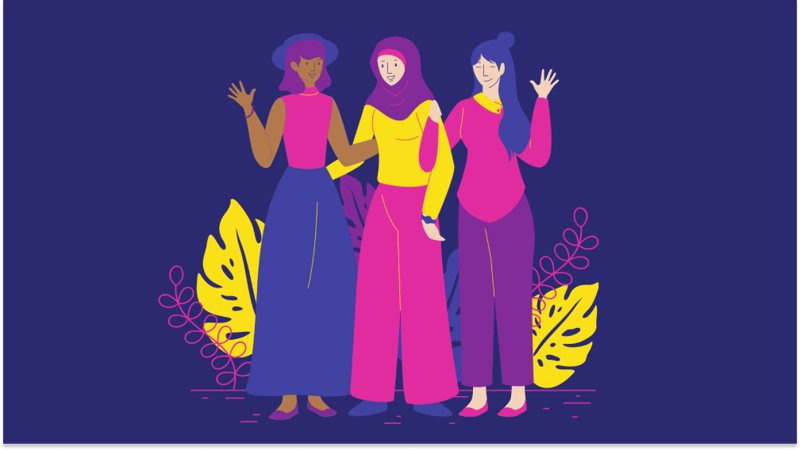Have you ever heard of the Bechdel Test?
It measures the representation of women in film, literature, television, and other media. To “pass” the test, the story has to include at least two named women who talk to each other about something other than a man.
When it comes to student affairs, I couldn’t help but wonder: Do institutions have their own version of a Bechdel test to guide students and staff toward making their programs and events as inclusive as possible?
The first step in being inclusive is to keep a wide variety of student identities, needs, and abilities — including underrepresented and historically marginalized ones — in mind. Note that these identities will vary depending on the institution. A Hispanic-serving institution and a tribal college will approach inclusion differently from a predominantly white university, for example.
According to research from the U.S. Department of Education, inclusive programs can make students into better, more responsible citizens. When students have the opportunity to engage in positive interactions with peers from backgrounds different from their own, they gain a greater sense of belonging to their institutions and communities.
It’s important to understand that striving for inclusivity doesn’t always result in perfectly inclusive programming. But just because you’ll likely make mistakes and won’t be 100% inclusive to everyone all the time, you shouldn’t stop making the effort. There is still tremendous value in being as accessible, accommodating, and welcoming as possible.

Inclusion should be a priority at the very beginning stages of your program planning and consistently revisited throughout the process.
So, here is our checklist of five things to keep in mind when creating inclusive programming for your students.
Identity Labels
Even if your student population appears to be homogeneous on paper, remember that every student has different social identities and lived experiences — which influence and inform how they navigate their surroundings. When planning programs for your students, it is important to know what different social identities are being represented on your campus.
Identities to consider include (but are not limited to) each student’s:
- Age
- Gender identity
- Gender expression
- Sex
- Race
- Ethnicity
- Sexual orientation
- Religious affiliation, practices, and beliefs
- Country of origin
- Socioeconomic status
- First language
- Marital/relationship status
- Veteran status
- Physical, emotional, and developmental (dis)abilities
Being familiar with different social identities can help carefully consider how each element of your programming may be interpreted and experienced.
If you want to learn more about the students on your campus, check out the facts or demographics page on your institution’s website. Or reach out to your admissions or institutional research offices to see if they have collected any student demographic data that hasn’t been publically shared.
Also talk with campus disability services, religious organization offices, LGBTQIA+ services, and other campuses offices to learn more about how you can better support and accommodate these students. Let the students’ needs guide you.
Themes
I’ve seen my fair share of programming themes, from “under the sea” to Disney to the NFL draft. While themes may seem like harmless fun, be wary of them coming at the expense of anyone’s identity or culture.
It is always important to vet your theme through multiple people. Beware of cultural appropriation wherein elements of a culture are adopted by folks outside of that culture, oftentimes in stereotypical and harmful ways. Cinco de Mayo celebrations and luau pool parties are common examples.
So, here are some questions to ask yourself and your program planning partners:
- In what ways could the theme be interpreted or misinterpreted?
- Does this theme tokenize or stereotype a group of people?
- Does this theme represent a culture or ethnicity? If so, is that culture or ethnicity directly related to the mission or identity of the students who are planning the program or being celebrated by it?
Incorporating a theme is not always inherently wrong, but it must be done carefully. If you find yourself being drawn to a theme that has a cultural component, figure out if you can make your program educational and authentic. Work with a student organization, community group, or someone in your area that holds those cultural identities and see if you can collaborate with them to make it an informative, engaging, and culturally affirming experience for everyone involved.
Marketing
At one of my former institutions, a group of student leaders turned their community walking trail into a haunted house for Halloween, complete with actors and props.
It was an engaging program with high attendance. However, the problem was with its title: the Trail of Fears, which mimicked the Trail of Tears, the forced removal and relocation of indigenous people from their own land. While the students certainly intended no harm, apologies had to be made and the accountability on all levels had to be strengthened moving forward.
The moral of the story is to make sure there are always people checking your work, vetting your ideas, and asking questions from an intersectional approach. This can include teammates who are working on the project with you, a supervisor or advisor, a colleague, or even a faculty member who is knowledgeable about the topic you’re trying to address.
It’s always nice to hear other people’s perspectives on our work. It can help illuminate any blind spots we have, especially when it comes to inclusivity.
Remember to also be careful with the language you use in your marketing. There are plenty of inclusive language pitfalls that can easily befall anyone. Many individuals are simply unaware of the origin of words or how certain words alienate or discriminate against a community of people. At a minimum, be sure to check for:
- Appropriated language or culture slangs
- Ableist language
- Gender bias and gender-neutral language
- Sexist, racist, and culturally insensitive imagery
You can also check out our blog post that’s all about inclusive language.
Accessibility
“Wow, I didn’t even think of that.”
That’s a common response I’ve received when I’ve pointed out possible barriers to participant access to an event.
It’s all-too-easy to mistakenly program for only your able-bodied students, completely ignoring many amazing students who would love to participate, too. You may go into autopilot when planning programs —assuming that the majority of students will be fine with whatever we plan for them.
But whether you have students with mobility needs, who are deaf or hard of hearing, or require service animals, your event needs to be comfortable, welcoming, and most importantly, accessible, for everyone.
Here are some questions to ask yourself and your team:
- What is the layout of the venue?
- What types of chairs and tables are available?
- Are the emergency routes in this venue accessible for everyone. regardless of ability?
- Is the venue accessible to guests in wheelchairs? Are there stairs, ramps, or elevators?
- If the venue is outside, what is its physical terrain?
- How are audio and visual elements accessible to deaf, hard of hearing, blind, and visually impaired attendees?
- Are there any materials that need to be sent out before the event to deaf, hard of hearing, blind, and visually impaired attendees?
Food
If you want students to come to your event, just offer free food, right? Er, not quite.
This belief has stood the test of time within student affairs, and many people still operate this way. It’s okay; I definitely did at one point in my career. While food usually does help drive up the attendance of your event, have you ever considered who it might be keeping away?
While it’s tempting to order quick and easy go-to items (like pizza), it’s more important to consider how food can impact your program in a negative way. Challenge yourself and your student leaders to crowdsource for information. Don’t just ask your students what their food preferences are; also inquire about their restrictions. Run polls, send out surveys, or just ask students as they pass by in the hallway.
Students have dietary restrictions for all kinds of reasons. Here are a few of the most common to be mindful of:
- Allergies (common ones include nuts, soy, and shellfish)
- Vegan, vegetarian, and pescaterian
- Religious restrictions (like Kosher and Halaal)
Work with your friends over at campus dining to see what meals or snacks they can prepare for your students with restrictions. Do a quick google search and if you are lucky, maybe you have restaurants in the area that you can get food catered from.
Be sure to also check calendars for religious holidays like Ramadan or Yom Kippur. If students are fasting during these holidays, you’ll need to get creative with the timing of your programs. Otherwise, students will be tempted by food they cannot eat or, more likely, they won’t even attend in the first place. (We wrote more about supporting religious minority students here.)
Knowledge and awareness are the top keys to inclusivity. We may not get it right every time, but it is important to keep each other accountable, ask our students about their needs, and do our best to support them.
What considerations did we miss? Share with us on Twitter at @themoderncampus and @Meg_Roll.





